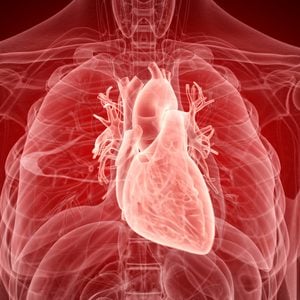Is Heart Disease Genetic?
Updated: Mar. 16, 2022
Your blue eyes, your brown hair, and, yes, your heart health can be passed down through the generations. Here's what to know about risk, treatments, and more.
What is heart disease?
This question sounds like it has a fairly obvious answer—a problem with your heart, right? Although heart disease sounds like a single condition, it actually covers many diseases that affect the heart or blood vessels. These problems most often include coronary heart disease, which can lead to heart attacks and strokes. In truth, heart disease is just one type of cardiovascular disease, which is any condition that affects the heart or blood vessels. Oftentimes “heart disease” is used interchangeably for all types of cardiovascular disease.
Other common types of cardiovascular disease include heart valve problems: Your heart has four valves that must work in harmony to keep blood flowing in proper direction. Problems with your valves can lead to arrhythmias in which the heart beats too slow, too fast, or irregularly.
Each of these types of cardiovascular disease is related to the heart’s ability to pump blood throughout the body effectively. Many of the biggest issues with heart disease arise due to atherosclerosis, or the accumulation of plaque along the walls of the arteries of the heart, which makes it tougher for blood to flow as smoothly. If a piece of this plaque breaks off and gets “stuck” as a clot in the wrong place, this can trigger a heart attack or stroke.
(Here are more heart disease facts you should know.)
How common is heart disease?
Heart disease is extremely common. It’s the leading cause of death in America, according to the Centers for Disease Control and Prevention (CDC), and 12.1 percent of the U.S. population is currently living with some form of heart disease.
About 655,000 Americans died from heart disease in 2018, and nearly 25 percent of all U.S. deaths can be attributed to some form of cardiovascular disease. (Here’s why Japan, Korea, and France are among the countries with the lowest heart attack rates.)
Is heart disease genetic?
This is not exactly a “yes” or “no” question, explains Carolyn Yung Ho, MD, the medical director of the Cardiovascular Genetics Center and an associate professor of cardiology at Harvard Medical School in Boston. Our overall heart health (or lack thereof) is a combo platter of genes and habits. You may have heard the old saying, “genes load the gun, but the environment pulls the trigger,” which is true.
Even the most problematic genes can lie dormant in most people if you make positive habits a priority.
A 2016 study in the New England Journal of Medicine reported that those with high genetic risk for heart disease had about double the risk for a heart attack or stroke. But they could trim their risk by a whopping 46 percent with healthy lifestyle choices, including not smoking, exercising at least once a week, eating a well-balanced diet, and maintaining a body mass index (BMI) less than 30.
The genetic material we inherit from our parents can alter our disease risk in a couple of different ways.
“One is through rare genetic changes in genes associated with specific diseases. If a parent has a condition, there is a 50 percent chance that each of their children could inherit the genetic mutation and be at higher risk for developing the disease themselves,” Dr. Ho says.
“The other way is through the collective impact of numerous common genetic changes that individually have a small effect on heart health. If by chance, we inherit a number of these common changes, our risk for developing heart disease can increase” she says.
There are also plenty of common gene variants that have a cardio-protective effect, and if we inherit these, Dr. Ho says, we may be at lower risk for developing heart disease.

Genetic heart disease conditions
There are many types of heart diseases that can be passed down genetically, these range from cardiomyopathies (the heart muscle becomes enlarged and rigid) to arrhythmias and other conditions.
It’s important to identify your risk early before you begin to develop symptoms that could potentially become life-threatening. Here are some of the more common types of genetic heart diseases.
Familial cardiomyopathies
Familial hypertrophic cardiomyopathy
This genetic heart disease is one of the two most common inherited cardiomyopathies. It’s caused by the mutation of one of several genes. So far scientists have discovered four primary genes that, when mutated, could lead to familial hypertrophic cardiomyopathy, a thickening in a portion or all of the heart muscle. The heart has to work harder to pump the same amount of blood, and due to the thicker muscle, the lower chambers of the heart—called ventricles—have less “real estate” for blood.
The result: possible shortness of breath and/or arrhythmia. It’s also possible to have familial hypertrophic cardiomyopathy and not experience any symptoms at all.
Treatment is mostly focused on managing symptoms and might include medication to limit swelling, prevent blood clots, or regulate the heart’s activities. Surgery, such as adding a pacemaker, removal of the thick portion, or a heart transplant, is sometimes an option. Losing weight, if necessary, and eating a healthy diet may help reduce your risk for complications as well.
Familial dilated cardiomyopathy
On the opposite end of the genetic heart disease range is familial dilated cardiomyopathy, which is another common inherited cardiomyopathy. Instead of a thicker muscle, genetic mutations in more than 30 genes cause the heart to grow weaker and thinner, and in turn, pump blood less efficiently. Left untreated, this can turn into heart failure. Symptoms might include fatigue, swelling in the stomach or legs, irregular heartbeat, or shortness of breath. Some people are completely asymptomatic.
Symptoms vary widely, and the treatment will be targeted to manage and limit those symptoms. (Here are tips from heart doctors on heart health.)
Arrhythmogenic right ventricular cardiomyopathy
Unlike some genetic heart diseases, arrhythmogenic right ventricular cardiomyopathy (ARVC), generally presents itself during adulthood. About half of cases run in families and this heart disease can be caused by a mutation on one of 13 genes. It involves a breakdown of the myocardium, which is the muscular wall in the heart.
Some cases are asymptomatic early on, but as it progresses, ARVC can lead to heart palpitations, fainting, arrhythmias, and in severe cases, sudden death (especially during intense exercise).
Restrictive cardiomyopathy
Even though the heart muscle can pump strongly, those with restrictive cardiomyopathy (RCM) have hearts that struggle to relax between beats. As a result, the heart has a tough time refilling with blood, and it instead gets backed up in the body—including the lungs. Although rare, many cases of RCM lead to heart failure later in life.
This condition tends to run in families, and symptoms include fatigue, shortness of breath, arrhythmia, coughing (especially if blood impacts the lungs), and fainting. Doctors treat the symptoms based on the cause. They may prescribe blood thinners, heart-healthy lifestyle changes, medicines to increase the heart’s efficiency, or in advanced situations, a heart transplant.
(These are the best heart hospitals in every state.)
Familial arrhythmias
Long QT syndrome
Electricity isn’t just what keeps the lights on; it also causes the heart to beat and be able to pump blood. “Long QT” is a measure of the heart’s electrocardiogram electrical activity. If cells take too long to recharge, this is diagnosed as long QT syndrome (LQTS) and can trigger arrhythmias, seizures, fainting, or sudden death.
It can be genetic (a mutation to a gene involved with sodium or potassium use) or acquired (caused by a medication or other condition), and it can be asymptomatic. Treatment options include beta-blocker medications, limiting strenuous activity, or inserting a pacemaker or implantable cardiac defibrillator.
Short QT syndrome
On the flip side, short QT syndrome (SQTS) means that the heart recovers very quickly between each beat. It’s a congenital heart disease inherited from one or both parents and affects potassium channels in the heart. Most individuals with SQTS experience symptoms like heart palpitations, a quicker-than-normal heart rate, fainting, atrial fibrillation, and in some sudden cardiac arrest and/or death.
Brugada syndrome
Brugada syndrome can be inherited from one or both parents through a mutated gene that makes the heart muscle cells react to sodium abnormally. The ventricles beat irregularly and blood can’t circulate as well as it normally would. Interestingly, this genetic heart disease can be temporary, although some with Brugada syndrome die in their sleep because it can fall dormant and be asymptomatic.
It’s most common in Asian men, and there’s currently no cure—only symptom treatment to reduce the risk for other heart issues. Symptoms include seizures, fainting, heart palpitations, and cardiac arrest.
Catecholaminergic polymorphic ventricular tachycardia
Catecholaminergic polymorphic ventricular tachycardia (CPVT) is a rare genetic heart disease that involves sudden and fast heartbeat from the two lower chambers of the heart, which are called ventricles. This condition is often present in childhood but occasionally diagnosed later in life. The heart beats so fast that it can’t refill enough between beats and the body doesn’t get enough blood.
It’s caused by a genetic mutation in one or both parents, and can trigger loss of consciousness, fainting (especially when stressed or emotional), cardiac arrest, and sometimes sudden cardiac death.
Treatment is essentially symptom management, such as beta-blocker medications or other medicines to limit abnormal heart rhythms and limiting strenuous activity.
Familial hypercholesterolemia
This heart disease is the genetic version of coronary heart disease. Everybody requires some cholesterol to function, but if too much of the “bad” kind, low-density lipoproteins (LDL), builds up within the body, it can narrow the heart’s arteries. A mutation on chromosome 19 means the body can’t remove LDL from the blood as it normally would.
As a result, LDL levels are often 190+ mg/dL in those with familial hypercholesterolemia, and if untreated, this inherited condition can progress into a stroke or heart attack. (Here’s what you need to know about chest pain that comes and goes.)
Medication is often necessary to help keep cholesterol levels in check, quitting smoking (if applicable), exercising consistently, and eating a well-balanced diet can help as well.
Marfan syndrome
Marfan syndrome is another inherited condition that damages the body’s connective tissues. It commonly affects the heart and blood vessels, but it could also impact the eyes and bones. Due to its impact on the heart and blood vessels, people with Marfan syndrome may experience aneurysms, according to The Marfan Foundation.
It’s essential to detect the life-threatening condition early to receive proper care and treatment. These options include blood pressure-lowering medications, eye care, and surgery. (Here are natural remedies for high blood pressure.)
Sudden arrhythmic death syndrome
If an individual has sudden arrhythmia death syndromes (SADS), the electrical aspects of the heart don’t fire properly, resulting in an abnormal heart rhythm. Family history of unexplained death prior to age 40, consistent chest pain, and fainting are usually the only way to distinguish if you’re at risk, according to the SADS Foundation. Unfortunately, many cases of SADS go undiagnosed until after a post-death investigation.
Other potential causes of heart disease
Satjit Bhusri, MD, founder of Upper East Side Cardiology in New York City compares the possible causes of heart disease to a recipe.
“Outside of the rare genetic heart disease, our genes are the initial ‘ingredients’ to ‘cooking’ our heart health risk. The remainder of the ingredients point us to lifestyle choices,” he says.
Genetic factors likely play some role in high blood pressure, heart disease, and other related conditions. It’s also probable, though, that people with a family history of heart disease share common environments and other factors that may increase their risk. For example, you were raised in a household in which your parents ate and fed you a high-sodium, rich-in-red-meat diet.
“The risk for heart disease can increase even more when heredity combines with unhealthy lifestyle choices, such as smoking cigarettes and eating an unhealthy diet,” Dr. Bhusri says.
The CDC explains that the most common possibly non-genetic heart disease risk factors include:
-
Smoking
-
Unhealthy diet
-
Physical inactivity
-
Excessive alcohol use
How to determine your potential genetic risk for heart disease
A great place to start is taking an account of your family’s medical history. The American Heart Association (AHA) has a free downloadable “My Family Health Tree” PDF to make this easier to track.
“Take advantage of the time connecting with your family to make a systematic assessment of the health of your relatives. In addition to your parents, siblings, and kids, also remember your grandparents, aunts, and uncles, cousins, nephews and nieces,” Dr. Ho says. (Here are heart disease risk factors you may not know.)
“Make note of which side of the family you are talking about, and talk about any important medical illnesses, as well as age and circumstances of how people passed away. Being organized can help you and your doctor identify important patterns,” she says.
A “family history of heart disease” is usually defined as:
-
Having a first-degree male relative (like a brother or dad) who had a heart attack before age 55, or
-
Having a first-degree female relative (such as a mom or sister) before age 65
A 2019 Canadian study in the journal Circulation suggests that scientists might be getting closer to a DNA test that can predict coronary artery disease risk. Using a “polygenic risk score” genetic assessment, the researchers studied DNA variations they thought might influence risk. They were able to detect about 7 percent of individuals at high risk using this data.
More research is needed, but this may be helpful in the future to assist with early detection and treatment of heart disease before it turns deadly.
Diagnosis and treatment options for heart disease
Whether you have a clean bill of heart health in your family history or not, “prevention and lifestyle choices are still front and center,” Dr. Bhusri says.
And if anything feels “off” in terms of your ticker, see a cardiologist for a check-up. This might include an electrocardiogram (EKG), echocardiogram, stress test, and/or a CAT scan of the heart to measure its efficiency and ability to pump properly. Blood work can also help detect early warning signs for risk factors, such as diabetes and high cholesterol.
If your blood sugar or cholesterol levels are outside of a healthy range, your doctor can help you integrate lifestyle changes and possibly prescribe medications to limit your overall risk profile.
The AHA recommends that all Americans—genetically-predisposed or not—try to follow these steps to lower their chances of being diagnosed with or dying from heart disease.
-
Quit smoking, if you do
-
Maintain a healthy weight
-
Eat a diet low in sodium and saturated fat and high in fiber, as part of a meal plan akin to the Mediterranean Diet
-
Aim for 150 minutes of moderate or 75 minutes of vigorous activity per week
-
Manage blood pressure, blood sugar, and cholesterol
“Try to reduce the risks that you can control,” Dr. Ho says. She adds, “Being healthy and active is the best defense and offense.”



